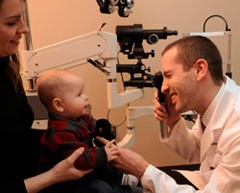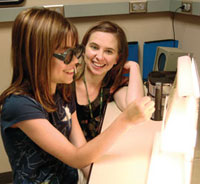An Inside Look at UAB’s Pediatric Optometry Service
By Caperton Gillett
 |
Optometry resident Nathan Steinhafel examines a seven-month-old patient. The UAB Pediatric Optometry Service sees children from birth up to age 18; it also provides vision therapy for patients of all ages. |
Kristine Hopkins, O.D., M.S.P.H., never knows what to expect from her patients when she gives them an eye exam. There’s the occasional spontaneous dance performance, for example, or unsolicited reports on the behavior of family members.
But that’s part of the adventure of being a pediatric optometrist, says Hopkins, chief of vision therapy at UAB Eye Care, the clinical arm of the School of Optometry. “The unpredictability of a four-year-old is what I live for from clinic day to clinic day,” she explains, standing in front of a toy-filled nook painted to resemble a jungle with peeping animal eyes. “It’s a really fun environment.”
It also can be a challenging one. The vast majority of patients in the pediatric optometry service are school-aged or younger, which means many may not be able to read the letters and numbers that make up a standard adult eye exam.
So optometrists like Hopkins rely on tools such as the Electronic Visual Acuity tester (EVA)—a setup with a computer and a TV screen to test young patients’ vision—and toys and videos to keep them occupied. “It’s mostly about having the right equipment to keep them involved,” Hopkins says. “We have to give them targets that are interesting and stimulating.”
Story continues after slideshow
Something from Nothing
Skill also comes into play. “We can’t always rely on our patients to give us good information,” Hopkins says. “But we don’t really need them to do much for us. Even if patients are not entirely cooperative, we can still get an excellent measure of their prescription and determine whether they need glasses. We can determine if their eyes are nice and straight and healthy. We can do eye exams on six-month-olds, who give us nothing, and we can still get a lot of good information.”
 |
Kristine Hopkins (right) works with a 10-year-old patient during a vision therapy session. |
The pediatric optometry service sees around 5,500 patients per year. In addition to eye exams and fittings for glasses and contact lenses, members of the service prescribe medications, perform evaluations to monitor conditions such as cataracts and retinal disease, and provide care for patients with special needs. They also offer vision therapy, which includes exercises and activities for patients who have trouble with eye-teaming—using both eyes in sync—and focusing. These problems can cause blurring, double vision, and headaches that, in turn, can significantly impact a child’s performance at school. An occupational therapist also sees patients two days a week to address difficulties with hand-eye coordination, handwriting, and visual perception.
Making a Difference
Research by UAB Eye Care faculty is also uncovering new clues to understanding and treating pediatric eye conditions. Among several local and federally funded projects, UAB investigators are participating in the Pediatric Eye Disease Investigator Group, a national network of optometrists and ophthalmologists who are making significant strides in the treatment of ambylopia (lazy eye) and other pediatric vision problems.
Community outreach is another focus for the pediatric optometry service. The Preschool Peepers program screens young children in the Birmingham area for vision problems. Pediatric optometrists regularly hold clinics for developmentally delayed children at UAB’s Sparks Clinics and United Cerebral Palsy’s Lincpoint clinics, and for students at the Alabama Institute for the Deaf and Blind. They also travel to underserved areas of the state and participate in international medical missions trips to provide free eye care and glasses to people in need.
“Pediatric optometry is extremely rewarding for me, because it makes such a big difference for my patients,” Hopkins says. “Whether it’s a simple pair of glasses, weeks of vision therapy, or a retinal exam that indicates a condition affecting the whole body, we are committed to helping children. Leveling the playing field for them is really important—it can give them a better future.”